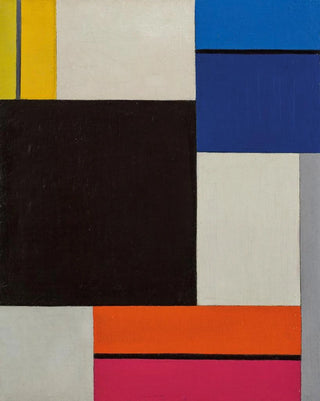Art print | Composition XXI - Theo van Doesburg


View from behind

Frame (optional)
In the fascinating world of modern art, few works manage to capture the spirit of an era while remaining timeless. "Composition XXI" by Theo van Doesburg is a perfect example. This iconic piece, created in 1929, embodies the ideals of the De Stijl movement, advocating harmony between art and architecture, as well as unity between form and color. Through its geometric lines and primary colors, Van Doesburg invites us to a visual exploration that transcends mere notions of aesthetics. The art print of this work offers a window into the innovative world of the early 20th century, where art was not just admired but became a true manifesto of life.
Style and uniqueness of the work
The strength of "Composition XXI" lies in its radical approach to composition. The artist uses a palette of vivid colors, mainly red, blue, and yellow, which clash and complement each other to create a dynamic balance. The straight lines and rectangular shapes, emblematic of the De Stijl style, juxtapose with mathematical precision, generating a sense of movement and depth. Each element seems carefully thought out to contribute to the whole, while maintaining an individuality that allows the viewer to immerse themselves in it. This play of contrasts and harmonies evokes a vision of the world where order and chaos coexist, reflecting the tensions of the era while opening the way to new creative possibilities.
The artist and his influence
Theo van Doesburg, a central figure of the De Stijl movement, was not only a painter but also an art theorist, an architect, and a designer. His commitment to abstraction and the simplification of forms has had a lasting impact on the development of modern and contemporary art. By founding the De Stijl group with Piet Mondrian, Van Doesburg sought to establish a universal visual language that would transcend cultures and eras. His influence is felt not only in painting but also in architecture and graphic design, where his principles of composition and color continue to inspire generations of artists. The richness

Matte finish

View from behind

Frame (optional)
In the fascinating world of modern art, few works manage to capture the spirit of an era while remaining timeless. "Composition XXI" by Theo van Doesburg is a perfect example. This iconic piece, created in 1929, embodies the ideals of the De Stijl movement, advocating harmony between art and architecture, as well as unity between form and color. Through its geometric lines and primary colors, Van Doesburg invites us to a visual exploration that transcends mere notions of aesthetics. The art print of this work offers a window into the innovative world of the early 20th century, where art was not just admired but became a true manifesto of life.
Style and uniqueness of the work
The strength of "Composition XXI" lies in its radical approach to composition. The artist uses a palette of vivid colors, mainly red, blue, and yellow, which clash and complement each other to create a dynamic balance. The straight lines and rectangular shapes, emblematic of the De Stijl style, juxtapose with mathematical precision, generating a sense of movement and depth. Each element seems carefully thought out to contribute to the whole, while maintaining an individuality that allows the viewer to immerse themselves in it. This play of contrasts and harmonies evokes a vision of the world where order and chaos coexist, reflecting the tensions of the era while opening the way to new creative possibilities.
The artist and his influence
Theo van Doesburg, a central figure of the De Stijl movement, was not only a painter but also an art theorist, an architect, and a designer. His commitment to abstraction and the simplification of forms has had a lasting impact on the development of modern and contemporary art. By founding the De Stijl group with Piet Mondrian, Van Doesburg sought to establish a universal visual language that would transcend cultures and eras. His influence is felt not only in painting but also in architecture and graphic design, where his principles of composition and color continue to inspire generations of artists. The richness






